Petronius, Satyricon 31, 33, and 34
translation and commentary by Will Roberts (’23)
Introduction
The Satyricon is a picaresque novel whose authorship is attributed to Gaius Petronius Arbiter. We know little about Petronius’ life, and what we do know comes to us from the Roman historian Tacitus. Tacitus (Annales 16.18) tells us that Petronius was a wealthy, pleasure-seeking noble who served as governor in the eastern province of Bithynia; it is also likely that he served as either consul or first magistrate of Rome (Kenney 2022). In any event, Petronius ultimately ended up in the inner circle of the Roman Emperor Nero where he was given the title of “judge of elegance” (arbiter elegantiae in Latin), a role which made him the final authority on all things concerning taste and refinement (Kenney 2022). Eventually, Petronius was forced to commit suicide after being accused of conspiracy against the emperor, a crime of which he was almost certainly innocent (Kenney 2022).
The following sections of the Satyricon are taken from perhaps its most famous episode: The Dinner of Trimalchio. Trimalchio is a wealthy, vulgar freedman (former slave) whose ill-begotten fortune and lack of social refinement provide a perfect vessel for Petronius’s satirical commentary. Despite its satirical nature, Trimalchio’s dinner nevertheless offers priceless insights into both Roman dining culture and Roman society at large.
Translation
Section 31
Nevertheless, an exceedingly elegant appetizer course was carried in; for indeed already all had reclined except Trimalchio himself, for whom the first place was reserved by a new custom. Furthermore, in the aperitif-tray, there was a donkey made of Corinthian bronze laden with a saddle bag which was holding white olives on one side and black olives on the other. Two plates, on the margins of which Trimalchio’s name was inscribed as well as their weight in silver, were covering the donkey. Furthermore, little iron bridges were holding up dormice sprinkled with honey and poppy seeds. Also, there were little hot sausages placed upon a silver grill, and, below the grill, there were Syrian plums with pomegranate seeds.
In section 32, we receive a comical physical description of our host Trimalchio; notably, his clothing and jewelry is described in detail. Around his neck he wears a purple-bordered napkin, one that imitates the purple-bordered togas worn by senators. Further adding to his charade are his gilded iron rings which mimic the solid gold rings that only free born knights were permitted to wear; as a freedman, Trimalchio is only legally allowed to wear iron rings (Hurschmann 2006). Nevertheless, it seems that Trimalchio is quite dedicated to constructing a veneer of privilege that adds to his dinner’s overall theme of impersonation and deception.
In the opening paragraph of section 33 (excluded in my translation), Trimalchio pompously asks his guests to forgive him for his previous absence that delayed the banquet and momentarily pardon him as he enjoys a board game that employs crystal gaming pieces and gold and silver coins instead of basic counters.
Section 33
. . . Meanwhile, while Trimalchio consumes commonplace chatter during the game, a tray with a basket was brought out to us while we were still eating the appetizer; in the basket, there was a wooden hen whose open wings were encompassing the basket, just as they do when they incubate eggs. At once, two slaves approached, and, with the music roaring, they began to search the straw, and immediately they handed to the guests the peacock eggs that they dug up. Trimalchio turned his face to this scene and said, “Friends, I ordered peacock eggs to be put under the hen. And by Hercules I fear now that the chicks are fully formed; nevertheless, let us test if they are still able to be sucked.” We receive snail spoons weighing no less than a half-pound, and we thrust through the eggs formed from fat flour. Indeed, I nearly threw out my share, for it seemed to me that already the egg had formed into a chick. Then, when I heard an experienced guest say, “in these eggs, I do not know what good things await us,” I cracked through the shell with my hand and saw the fattest figpecker surrounded with peppered yoke.
In the opening two paragraphs of section 34, Trimalchio offers a second glass of mulsum (honey wine), and the appetizers are carried away. In the process, a slave drops a silver dish, and, when the slave goes to pick up the dish, Trimalchio has him boxed on the ears and orders that the silver dish be swept away with the rest of the trash. After slaves wash the guests’ hands with wine, and Trimalchio provides a pretentious remark on equality, the following scene unfolds.
Section 34
. . . Immediately, glass amphorae sealed with gypsum were carried forth carefully, on the necks of which little labels were affixed with this inscription: OPIMIANUM FALERNIAN 100 YEARS.” While we read over the inscriptions, Trimalchio clapped his hands and said: “Alas, thus wine lives longer than little humanity. Therefore, let’s drink our fill. Wine is life. Truly, I present a vintage from the consulship of Opimius. Yesterday, I served wine not nearly as good, even though I had more honorable guests.” Therefore, while we were drinking and admiring the luxuries most carefully, a slave carried in a silver skeleton fitted so that its joints and dislocated vertebrae could be bent in every direction. When he had thrown the skeleton upon the table once and then again, and the pliant skeleton was imitating a few poses, Trimalchio cried out:
“Alas miserable us, how little humanity is nothing!
Thus, we will all be after Orcus will carry us away.
Therefore, let us live, while life is good.”
Commentary
Section 31
“appetizer course” (gustatio): The Roman cena (dinner) consisted primarily of two meals: the mensa prima (main course) and the mensa secunda (dessert), with the gustatio (appetizer) being a later addition to the menu (Gutsfeld 2006). Of course, the quality and length of a Roman cena varied depending on economic conditions and the occasion (Gutsfeld 2006). For example, the Roman satirical poet Juvenal notes that foods such as bacon and meat had, before his time, traditionally been reserved for birthday celebrations (Satires 11, 83-84). Trimalchio’s dinner is one of excessive expense and should be viewed as being decidedly distant from a conventional Roman cena. This is not to say, however, that Trimalchio’s ostentatious display is rooted entirely in literary fiction, as the excessive dinner parties of wealthy Romans are well recorded and satirized by other writers, such as Horace.
“had reclined… the first place was reserved by a new custom”: The Romans reclined on couches during their convivia (translated literally as “living together”), or “banquets.” These convivia took place in triclinia, or “dining rooms,” which consisted of three couches surrounding a table. The medius lectus (“middle couch”) was typically reserved for high-status guests, the imus lectus (“bottom couch,” to the left of the entrance) for the host and his family, and the summus lectus (“top couch,” to the right of the entrance) for low-status guests (Schmitt-Pantel 2006). Typically, the host would recline summus in imo (“the highest point on the bottom couch”) next to the guest of honor who reclined imus in medio (“the lowest point on the middle couch”); however, Trimalchio breaks this tradition by reclining summus in summo (“the highest point on the top couch”), hence my translation “for whom the first place was reserved by a new custom.” Trimalchio may have preferred this spot since its accessibility accommodates his late arrival and his temporary absence that occurs later in the narrative (Smith 1975, 67). It is also possible that he was mis-following the customary arrangement of a Greek symposium, where the guest of honor occupied the “topmost” couch to the right of the doorway (Plato, Symposium 177d). Once again, Trimalchio’s banquet defies convention.
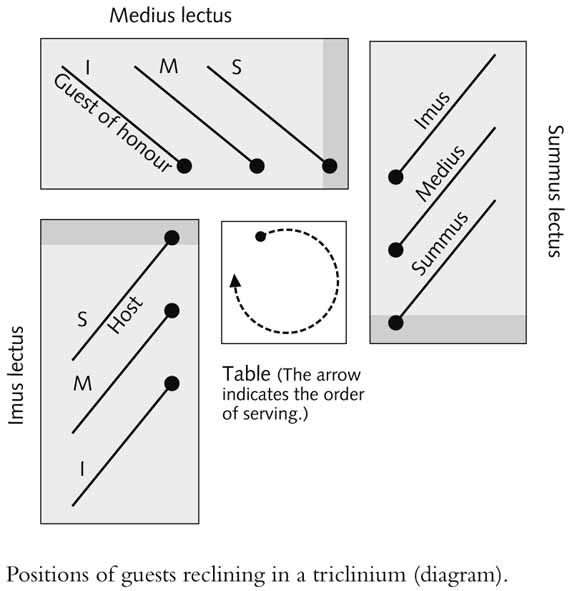
A diagram of the seating arrangements in a triclinium, from Schmitt-Pantel 2006
“a little donkey made of Corinthian bronze”: Trimalchio uses a statuette of a donkey made from Corinthian bronze to serve olives. Corinthian bronze was an alloy of copper, gold, and silver, though its exact composition remains unknown (Neudecker 2006). The alloy was highly valued, so much so that Pliny the Elder in his Natural History recalls a rumor that Mark Antony proscribed Cicero simply because he refused to hand over some pieces of Corinthian bronze (Natural History, 34.3). Trimalchio’s use of Corinthian bronze as tableware is clearly an outrageous display of wealth. It is also our first encounter with Trimalchio’s use of imitation in his banquet, a theme which recurs throughout the narrative. Though not made of Corinthian bronze, the image below shows a statuette of a donkey with a saddle bag similar to the one described in the narrative.

Statuette of a donkey with a saddle bag (asellus sum bisaccio), Museo Civico Castello Ursino, Catania; photograph courtesy of fellow classmate Emily Dixon
“white olives… black olives”: Olives were, and still are, a staple food across the Mediterranean and were common in Roman dinners. In Rome, as well as Greece, their oil was used both for consumption and personal hygiene. Though some of the olives carried by the donkey statuette are described as being albas (“white”), this description likely refers to their being an unripe light green in contrast to the ripened black olives on the other side of the saddlebag (Lawall 1995, 53). (For a recent news story about a bottle of olive oil that was preserved by the eruption of Mount Vesuvius in 79 CE, see https://www.oliveoiltimes.com/world/oldest-known-bottle-of-olive-oil-on-display-in-naples-museum/65708.)
“plates”: The Roman lanx was a large serving platter that served a variety of purposes (Matthews 1969, 32-33). For example, Vergil describes the vessel as being used in a sacrificial context (Georgics 2.194) Here, however, it is used exclusively as a piece of dining ware. Though not always this elaborate, below is a photograph of a silver Roman lanx from the British Museum; given Trimalchio’s tastes, it would not be unreasonable to imagine that the silver lances used to cover the donkey were equally elaborate.
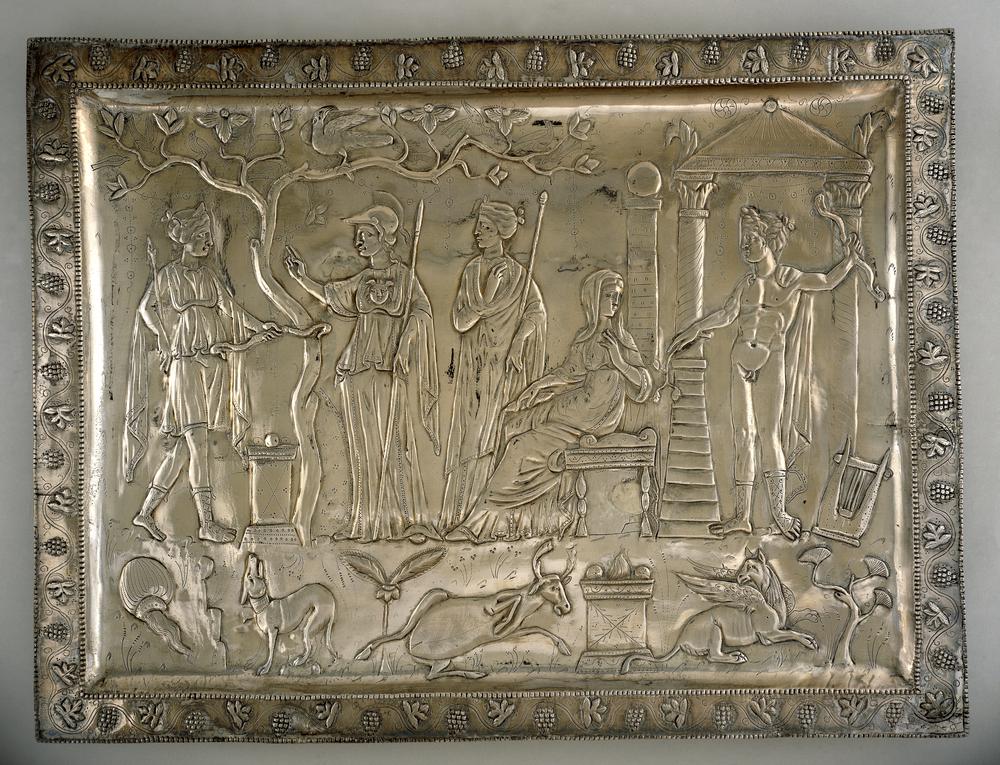
A 4th-century silver Roman lanx from Corbridge, England, depicting the divinities Diana, Minerva, and Apollo; British Museum, Accession Number: 1993,0401.1; inscribed on the base: “Weight fourteen (pounds) three ounces and two scruples”)
“Trimalchio’s name was inscribed as well as their weight in silver”: It was common for objects made of precious metals to be stamped with their weight, like the lanx shown above. This was done to denote the value of the object. Naturally, the heavier the weight, the more expensive the object. Indeed, some objects reached immense sizes; Pliny the Elder recalls a time in Roman history in which over 150 silver lances were made that weighed one hundred pounds each (Natural History, 33.145). The practice of inscribing one’s name on precious objects that were not used in the context of a religious offering, however, was likely looked down upon in Roman society as being vulgar and gaudy, further adding to Petronius’ characterization of Trimalchio’s offensive flamboyance (Sedgwick 1967, 93).
“dormice”: Dormice were considered a delicacy by the Romans, though they were by no means rare (Smith 1975, 67). In fact, the Romans kept dormice in special terracotta enclosures called gliraria, in which they were bred and fattened for consumption (Hünemörder 2006). The practice of raising dormice was unsuccessfully prohibited by sumptuary laws (laws which sought to regulate extravagance) during the late Roman Republic (Hünemörder 2006). For more details on the raising of dormice, see Book 3 section 15 of Varro’s On Agriculture. See below for photographs of an adorable dormouse and a Roman glirarium. Further, click the link for a recipe for “dormice” a la Trimalchio: https://romanasum.com/2019/06/30/honey-poppyseed-dormice/
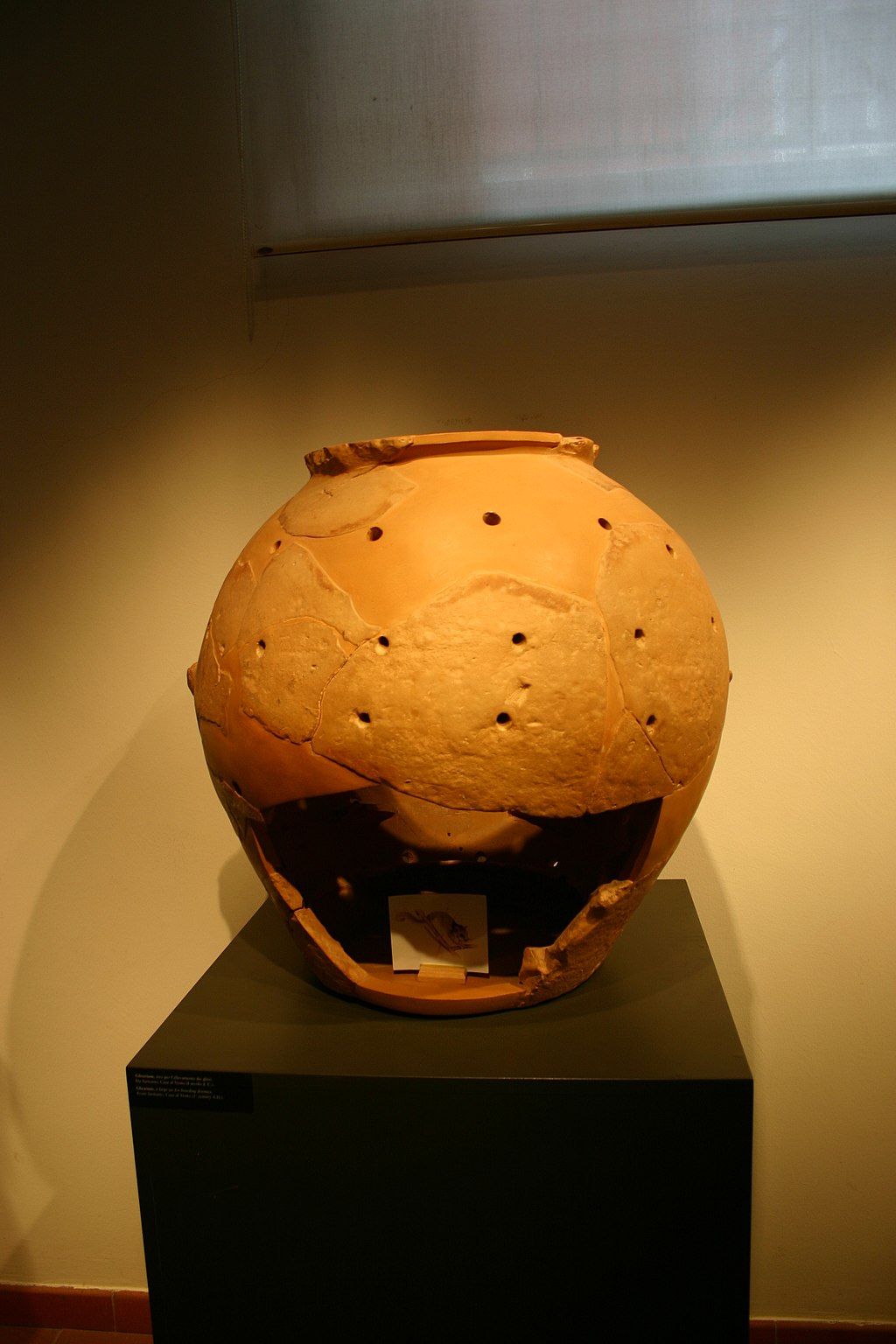
A photograph of a glirarium exhibited at the National Museum of Archeology in Chiusi. Wikimedia, CC-BY-SA, Marco Daniele
“Syrian plums with pomegranate seeds”: Syrian plums were praised for being good for the stomach and for being a reliable diuretic; pomegranate seeds (in Latin, grana Punici mali, or “grains of the Punic apple) were also consumed for their similar qualities (Hünemörder 2006). Here, the dark plums arranged together with the pomegranate seeds are meant to represent the coals and glowing embers under the silver grill that are “heating” the sausages. Once again, Trimalchio displays his love of illusion and mimicry. Though not arranged in the manner described above, below is a photograph of plums alongside pomegranate seeds to give you an idea of how their colors might clash together to create the effect of coals and embers.
Section 33
“the game”: Dr. Lawall posits that Trimalchio is playing the board game duodecim scripta (twelve lines) which involves the use of a board that has twelve vertical lines divided by one horizontal line; each player has fifteen markers and three dice which they role to move their markers (Lawall 1995, 61). The game is similar to modern backgammon (Smith 1975, 70). Learn to play the game using this link.
“wooden hen… peacock eggs… formed from fat flour… fattest figpecker”: Once again, Trimalchio serves a dish that is not quite what it appears to be by using yet another statuette of an animal to serve his bizarre dishes; this time, it is a wooden hen. Like dormice, both peacocks and their eggs were considered delicacies, though they were not overly rare (Smith 1975, 71). Of course, here Trimalchio does not serve peacock eggs at all, but rather pastries formed in the shape of peacock eggs that hold figpeckers (small birds also known as “Flycatchers” which were also considered a delicacy) submerged in a spiced yoke (Hünemörder 2006). The principal intrigue of this dish, however, is Trimalchio’s use of deception to make food items that are not necessarily all that exotic appear unique and luxurious (Smith 1975, 71). Click this link for a fun recreation of this strange dish.
“face to this scene”: The phrasing here is significant, particularly Petronius’ use of the word scena or “scene.” This word adds considerably to the theatrical display of the whole affair by portraying Trimalchio as a sort of stage director who wishes to put on a performance for his “audience” (i.e., his guests) (Smith 1975, 71).
“by Hercules”: In Latin, mehercules. A common interjection in Latin which invokes the mythological hero Hercules, a figure associated with strength, struggle, and triumph. By invoking the authority of Heracles, the interjection intensifies the force of the speaker’s statement. Mehercules is roughly equivalent to the English interjections “by God” or “indeed.” Here, Trimalchio uses this intensifying interjection to toy with his guests by deceptively emphasizing his false ignorance about the true nature of the “peacock” eggs.
“snail spoons”: In Latin, cochlearia, which is derived from the Latin word cochlea (“snail”). These small spoons came equipped with a point at the end of the handle that was typically used for removing snails from their shells, though of course, as in this instance, they could be used for eating other foods such as eggs; notably, Trimalchio’s cochlearia, severing as yet another instance of Trimalchio’s excess, are actually quite heavy, weighing in at a half-pound (Smith 1975, 71). Below is a photograph of an engraved cochlearium from the British Museum.

A silver cochlearium with an engraved and gilded bird from Hoxne, England; British Museum, Accession Number 1994,0408.80
Section 34
“glass amphorae sealed with gypsum”: Though the Romans did indeed use glass amphorae, few survive into the present day (Scheibler and Ingeborg 2006). Gypsum, a plaster like substance, was used to seal amphora and other containers to make them airtight as a means of preserving their contents (Hünemörder 2006).
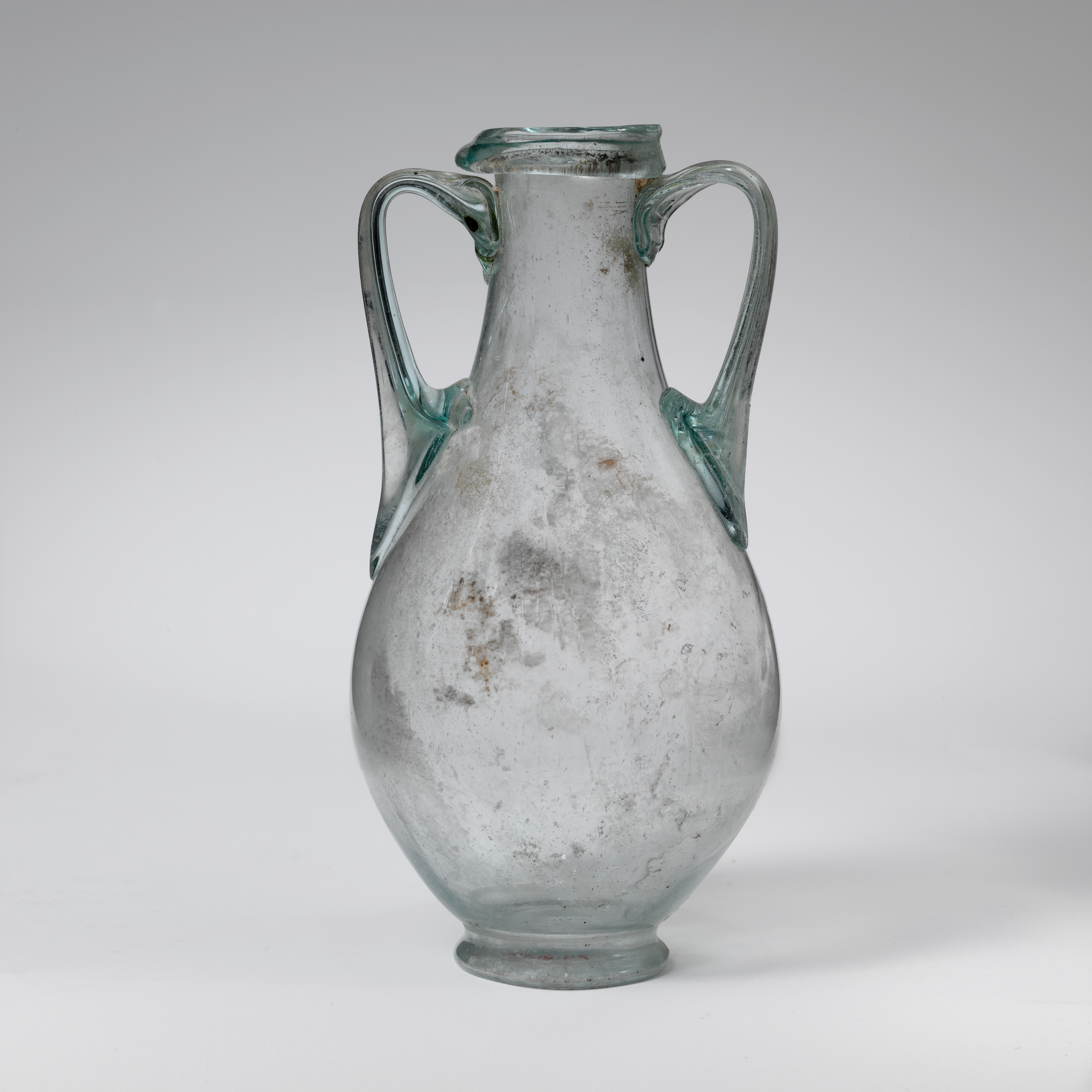
A photograph of a 1st-century CE Roman glass amphora from Cyprus; Metropolitan Museum of Art, Accession Number: 74.51.130
“OPIMIANUM FALERNIAN 100 YEARS… from the consulship of Opimius “: The inscription on the wine’s label displays both the wine’s type and date. Trimalchio serves his guests Falernian wine, one of Rome’s most popular vintages (Sedgwick 1967, 94). Falernian wine is also mention by other writers such as Catullus and Horace. The word “Opinianum” refers to wine from the year 121 BCE, the year of the consul Lucius Opimius (Smith 1975, 73). Roman years were dated by consulships; consuls, wielding vast executive power, were the highest elected political officials in the Roman republic, with two consuls holding concurrent yearlong terms. By the time of the Empire, the consuls were merely symbolic in nature, serving as mere relics of Rome’s republican past. According to Pliny the Elder, wine from the consulship of Opimius had survived well into his day, though he claims its age prevents the wine from being able to be consumed alone; rather, Pliny says that its only real virtue lies in its ability to improve the flavor of other younger wines (Natural History, 14.55-56). Regarding the mention of “100 YEARS,” Dr. Smith notes that most Roman inscriptions of this nature are used for wines that are “only a few years old” (Smith 1975). Given Trimalchio’s presentation of an almost undrinkable wine combined with his absurd display of the wine’s dating, Trimalchio boorishly exaggerates the grandeur of his generosity while simultaneously revealing his vulgar ignorance with regard to how the wine is supposed to be served.
“silver skeleton”: Though Trimalchio’s banquet is full of idiosyncrasies, this skeleton is not one of them. Mentions of death and skeleton imagery were actually quite common in Roman dining settings and served to remind both guests and hosts alike of the Latin phrase memento mori, in English, “remember that you die” (Soth 2019). Trimalchio’s luxurious silver skeleton is his own personal larva convivalis (“convivial skeleton”). Miniature skeletons were typically given to guests as dinner gifts (Soth 2019). Like Trimalchio’s silver skeleton, these skeletons were fitted with jointed limbs that allowed their owners to arrange them in different poses, however they were typically made of bronze rather than precious metals (Soth 2019). As recorded by Cassius Dio, the Roman emperor Domitian famously held a death-themed banquet at which he gave his guests silver tombstones with their names engraved on them as dinner gifts. Below are photographs both of a larva convivalis and of a mosaic of a party-ready skeleton found in Pompeii. Click this link for a wonderful video on death and Roman dining.

A photograph of a miniature bronze larva convivalis; Wellcome Collection, University of London, Accession Number: A629420
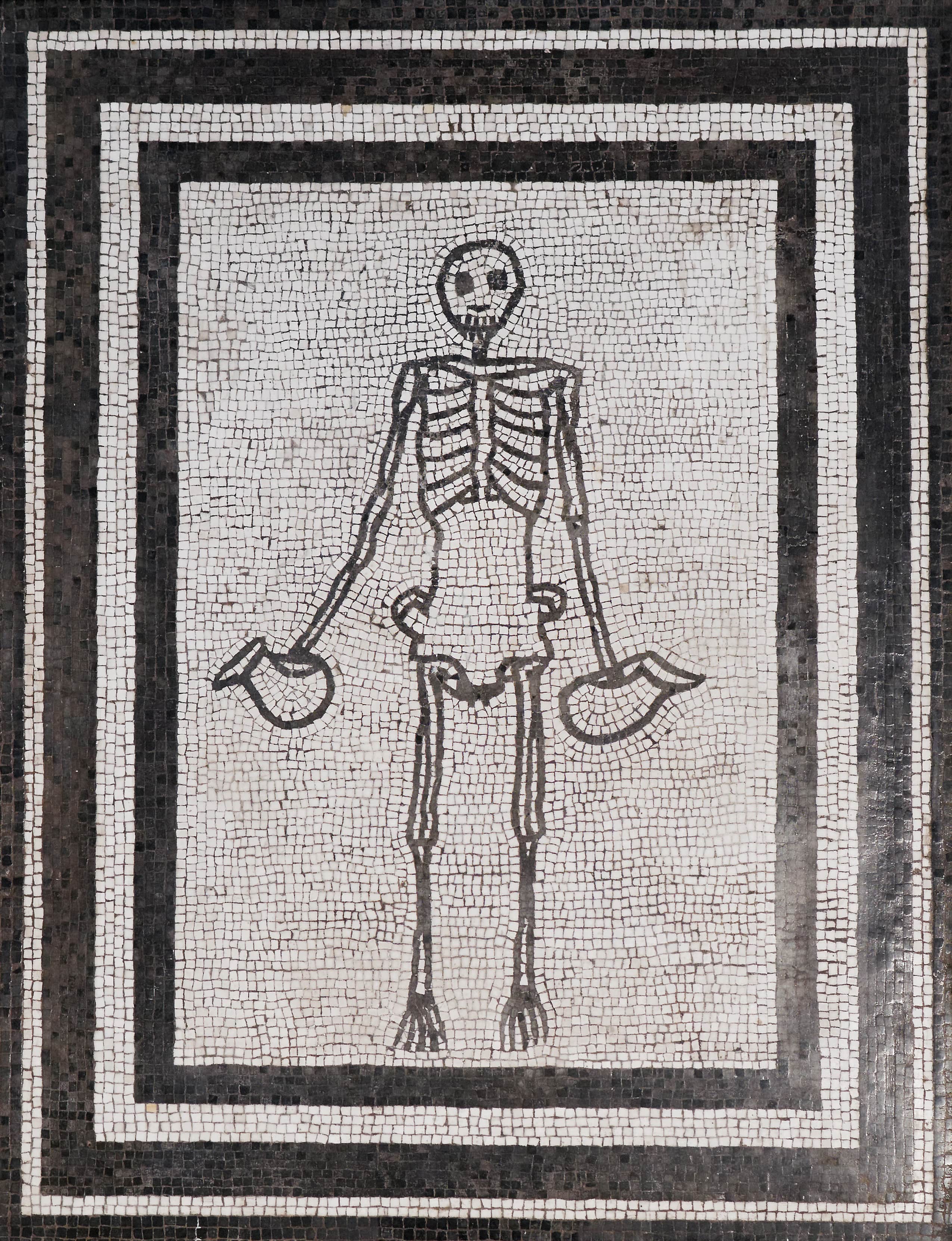
A photograph of a skeleton mosaic found in Pompeii; Naples National Archaeological Museum Accession Number: 9978
Sources
Gutsfeld, Andreas. 2006. “Cena.” In Brill’s New Pauly, edited by Hubert Cancik, Helmuth Schneider, and Christine F. Salazar. Leiden: Brill. Accessed April 17, 2022. http://dx.doi.org.newman.richmond.edu:2048/10.1163/1574-9347_bnp_e230040.
Hünemörder, Christian. 2006. “Dormouse.” In Brill’s New Pauly, edited by Hubert Cancik, Helmuth Schneider, and Christine F. Salazar. Leiden: Brill. Accessed April 21, 2022. https://referenceworks.brillonline.com/entries/brill-s-new-pauly/*-e1112210
Hünemörder, Christian. 2006. “Flycatcher.” In Brill’s New Pauly, edited by Hubert Cancik, Helmuth Schneider, and Christine F. Salazar. Leiden: Brill. Accessed April 21, 2022. https://referenceworks.brillonline.com/entries/brill-s-new-pauly/*-e1112210
Hünemörder, Christian. 2006. “Gypsum.” In Brill’s New Pauly, edited by Hubert Cancik, Helmuth Schneider, and Christine F. Salazar. Leiden: Brill. Accessed April 21, 2022. https://referenceworks.brillonline.com/entries/brill-s-new-pauly/*-e424520
Hünemörder, Christian. 2006. “Plum.”’ In Brill’s New Pauly, edited by Hubert Cancik, Helmuth Schneider, and Christine F. Salazar. Leiden: Brill. Accessed April 21, 2022. https://referenceworks.brillonline.com/entries/brill-s-new-pauly/*-e917200
Hurschmann, Rolf. 2006. “Lanx.” In Brill’s New Pauly, edited by Hubert Cancik, Helmuth
Schneider, and Christine F. Salazar. Leiden: Brill. Accessed April 21, 2022. https://referenceworks.brillonline.com/entries/brill-s-new-pauly/*-e630480
Hurschmann, Rolf. 2006. “Ring.” In Brill’s New Pauly, edited by Hubert Cancik, Helmuth Schneider, and Christine F. Salazar. Leiden: Brill. Accessed April 18, 2022. https://referenceworks.brillonline.com/entries/brill-s-new-pauly/*-e1023370
Kenney, E. John. 2022. “Gaius Petronius Arbiter.” In Encyclopedia Britannica. Accessed April 22, 2022. https://www.britannica.com/biography/Gaius-Petronius-Arbiter
Lawall, Gilbert. 1995. Petronius: Selections From the Satyricon. Wauconda: Bolchazy-Carducci Publishers.
Matthews, Kenneth D. 1969. “Scutella, Patella, Paterna, Patina” Expedition Magazine 11.4: 30-42. Accessed April 29, 2022. https://www.penn.museum/sites/expedition/scutella-patella-paterna-patina/.
Neudecker, Richard. 2006. “Corinthian Alloy.” In Brill’s New Pauly, edited by Hubert Cancik, Helmuth Schneider, and Christine F. Salazar. Leiden: Brill. Accessed April 19, 2022. https://referenceworks.brillonline.com/entries/brill-s-new-pauly/*-e620360
Scheibler and Ingeborg. 2006. “Amphora.” In Brill’s New Pauly, edited by Hubert Cancik, Helmuth Schneider, and Christine F. Salazar. Leiden: Brill. Accessed April 21, 2022. https://referenceworks.brillonline.com/entries/brill-s-new-pauly/*-e119010
Schlapbach, Karin. 2006. “Orcus.” In Brill’s New Pauly. edited by Hubert Cancik, Helmuth Schneider, and Christine F. Salazar. Leiden: Brill. Accessed April 17, 2022. https://referenceworks.brillonline.com/entries/brill-s-new-pauly/*-e900320
Schmitt-Pantel, Pauline. 2006. “Triclinium.” In Brill’s New Pauly. edited by Hubert Cancik, Helmuth Schneider, and Christine F. Salazar. Leiden: Brill. Accessed April 19, 2022. https://referenceworks.brillonline.com/entries/brill-s-new-pauly/*-e1220340
Sedgwick, W.B. 1967. The Cena Trimalchionis of Petronius. Oxford: Clarendon Press.
Smith, Martin S. 1975. Cena Trimalchionis. Oxford: Clarendon Press.
Soth, Amelia. 2019. “A Roman Feast… of Death!.” JSTOR Daily. Accessed April 24, 2022. https://daily.jstor.org/a-roman-feast-of-death/